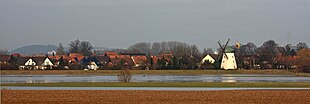Tündern
|
Tündern
City of Hameln
|
|
|---|---|
| Coordinates: 52 ° 3 ′ 53 ″ N , 9 ° 22 ′ 35 ″ E | |
| Height : | 70 m |
| Area : | 10.6 km² |
| Residents : | 2608 (Dec. 31, 2016) |
| Population density : | 246 inhabitants / km² |
| Incorporation : | 1st January 1973 |
| Postal code : | 31789 |
| Area code : | 05151 |

Tündern is a district of the city of Hameln in the Hameln-Pyrmont district in Lower Saxony, south of the center . The place lies in an arch of the Weser flowing past to the west and is connected to the city center via state road 424. In terms of area, Tündern is the largest single district in Hameln.
history
Tündern was first mentioned in 1004 under the name Tundirum in a document from the Kemnade monastery. In the Middle Ages, the high court of justice of the Ohsen Office was located near the place on the so-called Tündernanger, where a witch burning took place in 1583 . The last execution took place here in 1763 with the hanging of a horse thief.
On January 1st, 1973 Tündern was incorporated into the district town of Hameln.
Tündern train station
The place had a train station on the Hanover – Altenbeken railway line . This was set up as a breakpoint in 1913. Since the place was only about one kilometer away from the Bückeberg , this stop was converted into a four-track "Führerbahnhof" as part of the expansion work for the Reichserntedankfest in 1935. This had particularly long platforms for Hitler's special train. The adjoining building received eight ticket offices. In addition, a ramp was built on which Adolf Hitler's company car could be unloaded.
After the Second World War , the platforms that were not needed were dismantled and the station was downgraded to a stop. In 1964 the stopping point was abandoned and the building was used as a block. In the late 1970s, it became redundant and demolished. Remnants of the car ramp can still be found.
politics
Elke Meyer is the local mayor.
coat of arms
Shield split lengthways by black bars. On the left, three blue water waves on a silver background. On the right, on a blue background, is a golden sheaf of grain.
Culture and sights
- The Dutch windmill was built in 1883 and today gives an insight into the life of a miller.
- A village museum is run by the Association for Homeland Care and Border Relationships Tundirum . A historic cottage garden is attached to it.
Tündern is home to a table tennis club of the Oberliga Nord-West TSV Schwalbe Tündern and a football club HSC BW Tündern . The Hameln juvenile prison, which is the largest juvenile prison in Germany with 793 prison places, is located near Tündern outside the development .
Personalities
- 1583 were executed in a witch trial : the Walterbergische, the Flentsche, the Schutmensche.
- The most famous citizen was the former mayor Werner Bruns (1925-1994), who was also deputy district administrator of the Hameln-Pyrmont district for 20 years . A street in Hameln was named after him as Bürgermeister-Bruns-Straße because he made a significant contribution to the preservation of the old town. He was a bearer of the Federal Cross of Merit and a member of the Evangelical State Synod. In the locality he was called the "Lion of Tunders".
- The table tennis player Dimitrij Ovtcharov is one of the most famous Tünderans. He played in the Bundesliga team at TSV Schwalbe Tündern and won bronze medal at the 2012 Olympic Games (table tennis) both individually and with the German team.
Web links
Individual evidence
- ^ Federal Statistical Office (ed.): Historical municipality directory for the Federal Republic of Germany. Name, border and key number changes in municipalities, counties and administrative districts from May 27, 1970 to December 31, 1982 . W. Kohlhammer GmbH, Stuttgart and Mainz 1983, ISBN 3-17-003263-1 , p. 189 .
- ↑ Martin Weltner: For the Reich farmers' day . In: Lok Magazin . tape 10/2017 . GeraMond Verlag , Munich, p. 92 .
- ^ Local council Tündern
- ↑ Witch trial files from 1583 against the Walterbergische, the Flentsche, the Schutmensche



